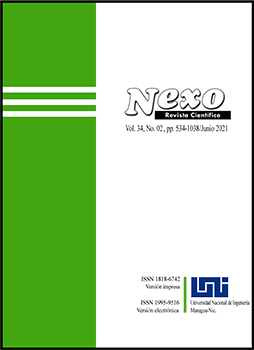Laboratory study and measurement of stiffness and compaction of unsaturated clay soil by using the innovative rebound hammer
DOI:
https://doi.org/10.5377/nexo.v34i02.11557Keywords:
rebound Hammer, compressive behavior, soil stiffness, spring-damper model, unsaturated clayAbstract
Defining soil behavioral parameters, which eventually results in predicting every short-term and long-term soil behavior, has continually been one of the interests of soil mechanics and has been of exceptional value. To this end, in this study, a novel method has been reviewed to determine the compressive behavior of fine-grained soils in the laboratory and the field, without sampling by the patented electronic device. In the lab, homogeneous materials of the intended soil underwent the compaction test, mechanical and physical tests, direct shear test, and impacts of the innovative rebound hammer in the horizontal and vertical directions in the test-box. The impact shear waves produce resistance and voltage output by force and dislocation sensors with high-sensitivity proportional to the pressure based on the soil surface stiffness. The obtained voltages are then converted to digital by an analog-to-digital converter and a microcontroller. Next, a number is shown on display by the "CodeVision" program. Then, by solving a quasi-dynamic equation (Viscoelastic spring-damper model) by MATLAB software and with the aid of laboratory-field results and correlation equations, a fitting connection between all effective mechanical soil parameters has been estimated to an acceptable extent. The effective mechanical parameters of the soil include the compaction percentage, specific gravity, and frequency of the system in the damped and non-damped states, the energy imposed on the soil, and the plastic stage strain in the range of less than 15% humidity. The results determine that increased hammering numbers are directly related to increased soil compaction and stiffness. In more detail, the reading of hammer numbers less than 2 corresponds to compaction of less than 75%, while the reading of hammer numbers greater than 3 in the vertical and 2.94 in the horizontal directions on clay surfaces designates compaction of 90%.
Downloads
1508
Downloads
Published
How to Cite
Issue
Section
License
The authors who publish in Nexo Scientific Journal agree to the following terms:
- Authors retain the copyright and grant the journal the right of the first publication under the license Creative Commons Attribution License, which allows others to share the work with a recognition of the authorship of the work and the initial publication in Nexo Scientific Journal.
- Authors may separately establish additional agreements for the non-exclusive distribution of the version of the work published in the journal (for example, in an institutional repository or a book), with the recognition of the initial publication in Nexo Scientific Journal.
- Authors are allowed and encouraged to disseminate their works electronically (for example, in institutional repositories or in their own website) before and during the submission process, as it can lead to productive exchanges, as well as earlier and greater citation of published works.










